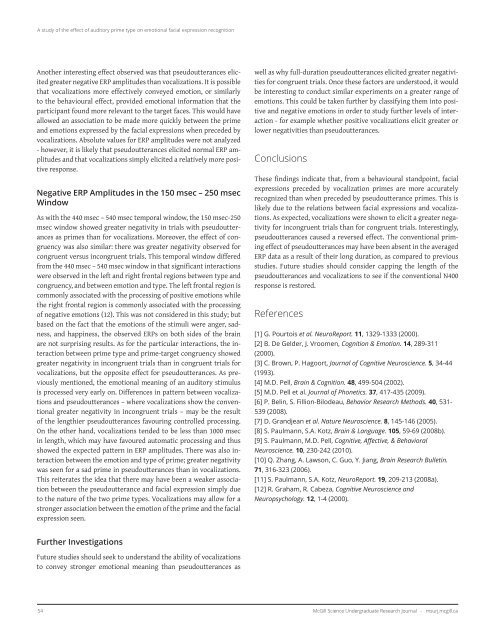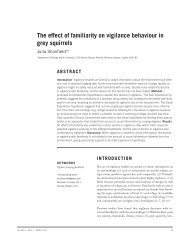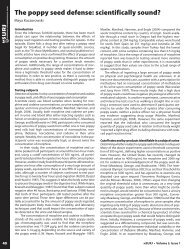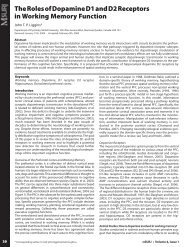the entire issue - McGill Science Undergraduate Research Journal ...
the entire issue - McGill Science Undergraduate Research Journal ...
the entire issue - McGill Science Undergraduate Research Journal ...
Create successful ePaper yourself
Turn your PDF publications into a flip-book with our unique Google optimized e-Paper software.
A study of <strong>the</strong> effect of auditory prime type on emotional facial expression recognition<br />
Ano<strong>the</strong>r interesting effect observed was that pseudoutterances elicited<br />
greater negative ERP amplitudes than vocalizations. It is possible<br />
that vocalizations more effectively conveyed emotion, or similarly<br />
to <strong>the</strong> behavioural effect, provided emotional information that <strong>the</strong><br />
participant found more relevant to <strong>the</strong> target faces. This would have<br />
allowed an association to be made more quickly between <strong>the</strong> prime<br />
and emotions expressed by <strong>the</strong> facial expressions when preceded by<br />
vocalizations. Absolute values for ERP amplitudes were not analyzed<br />
- however, it is likely that pseudoutterances elicited normal ERP amplitudes<br />
and that vocalizations simply elicited a relatively more positive<br />
response.<br />
Negative ERP Amplitudes in <strong>the</strong> 150 msec – 250 msec<br />
Window<br />
As with <strong>the</strong> 440 msec – 540 msec temporal window, <strong>the</strong> 150 msec-250<br />
msec window showed greater negativity in trials with pseudoutterances<br />
as primes than for vocalizations. Moreover, <strong>the</strong> effect of congruency<br />
was also similar: <strong>the</strong>re was greater negativity observed for<br />
congruent versus incongruent trials. This temporal window differed<br />
from <strong>the</strong> 440 msec – 540 msec window in that significant interactions<br />
were observed in <strong>the</strong> left and right frontal regions between type and<br />
congruency, and between emotion and type. The left frontal region is<br />
commonly associated with <strong>the</strong> processing of positive emotions while<br />
<strong>the</strong> right frontal region is commonly associated with <strong>the</strong> processing<br />
of negative emotions (12). This was not considered in this study; but<br />
based on <strong>the</strong> fact that <strong>the</strong> emotions of <strong>the</strong> stimuli were anger, sadness,<br />
and happiness, <strong>the</strong> observed ERPs on both sides of <strong>the</strong> brain<br />
are not surprising results. As for <strong>the</strong> particular interactions, <strong>the</strong> interaction<br />
between prime type and prime-target congruency showed<br />
greater negativity in incongruent trials than in congruent trials for<br />
vocalizations, but <strong>the</strong> opposite effect for pseudoutterances. As previously<br />
mentioned, <strong>the</strong> emotional meaning of an auditory stimulus<br />
is processed very early on. Differences in pattern between vocalizations<br />
and pseudoutterances – where vocalizations show <strong>the</strong> conventional<br />
greater negativity in incongruent trials – may be <strong>the</strong> result<br />
of <strong>the</strong> lengthier pseudoutterances favouring controlled processing.<br />
On <strong>the</strong> o<strong>the</strong>r hand, vocalizations tended to be less than 1000 msec<br />
in length, which may have favoured automatic processing and thus<br />
showed <strong>the</strong> expected pattern in ERP amplitudes. There was also interaction<br />
between <strong>the</strong> emotion and type of prime; greater negativity<br />
was seen for a sad prime in pseudoutterances than in vocalizations.<br />
This reiterates <strong>the</strong> idea that <strong>the</strong>re may have been a weaker association<br />
between <strong>the</strong> pseudoutterance and facial expression simply due<br />
to <strong>the</strong> nature of <strong>the</strong> two prime types. Vocalizations may allow for a<br />
stronger association between <strong>the</strong> emotion of <strong>the</strong> prime and <strong>the</strong> facial<br />
expression seen.<br />
well as why full-duration pseudoutterances elicited greater negativities<br />
for congruent trials. Once <strong>the</strong>se factors are understood, it would<br />
be interesting to conduct similar experiments on a greater range of<br />
emotions. This could be taken fur<strong>the</strong>r by classifying <strong>the</strong>m into positive<br />
and negative emotions in order to study fur<strong>the</strong>r levels of interaction<br />
- for example whe<strong>the</strong>r positive vocalizations elicit greater or<br />
lower negativities than pseudoutterances.<br />
Conclusions<br />
These findings indicate that, from a behavioural standpoint, facial<br />
expressions preceded by vocalization primes are more accurately<br />
recognized than when preceded by pseudoutterance primes. This is<br />
likely due to <strong>the</strong> relations between facial expressions and vocalizations.<br />
As expected, vocalizations were shown to elicit a greater negativity<br />
for incongruent trials than for congruent trials. Interestingly,<br />
pseudoutterances caused a reversed effect. The conventional priming<br />
effect of pseudoutterances may have been absent in <strong>the</strong> averaged<br />
ERP data as a result of <strong>the</strong>ir long duration, as compared to previous<br />
studies. Future studies should consider capping <strong>the</strong> length of <strong>the</strong><br />
pseudoutterances and vocalizations to see if <strong>the</strong> conventional N400<br />
response is restored.<br />
References<br />
[1] G. Pourtois et al. NeuroReport. 11, 1329-1333 (2000).<br />
[2] B. De Gelder, J. Vroomen, Cognition & Emotion. 14, 289-311<br />
(2000).<br />
[3] C. Brown, P. Hagoort, <strong>Journal</strong> of Cognitive Neuroscience. 5, 34-44<br />
(1993).<br />
[4] M.D. Pell, Brain & Cognition. 48, 499-504 (2002).<br />
[5] M.D. Pell et al. <strong>Journal</strong> of Phonetics. 37, 417-435 (2009).<br />
[6] P. Belin, S. Fillion-Bilodeau, Behavior <strong>Research</strong> Methods. 40, 531-<br />
539 (2008).<br />
[7] D. Grandjean et al. Nature Neuroscience. 8, 145-146 (2005).<br />
[8] S. Paulmann, S.A. Kotz, Brain & Language. 105, 59-69 (2008b).<br />
[9] S. Paulmann, M.D. Pell, Cognitive, Affective, & Behavioral<br />
Neuroscience. 10, 230-242 (2010).<br />
[10] Q. Zhang, A. Lawson, C. Guo, Y. Jiang, Brain <strong>Research</strong> Bulletin.<br />
71, 316-323 (2006).<br />
[11] S. Paulmann, S.A. Kotz, NeuroReport. 19, 209-213 (2008a).<br />
[12] R. Graham, R. Cabeza, Cognitive Neuroscience and<br />
Neuropsychology. 12, 1-4 (2000).<br />
Fur<strong>the</strong>r Investigations<br />
Future studies should seek to understand <strong>the</strong> ability of vocalizations<br />
to convey stronger emotional meaning than pseudoutterances as<br />
54<br />
<strong>McGill</strong> <strong>Science</strong> <strong>Undergraduate</strong> <strong>Research</strong> <strong>Journal</strong> - msurj.mcgill.ca









